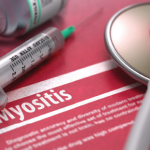He says the induction phase of treatment—the period of “trying to quickly get the fire as small as possible”—now involves IVIG more frequently, which can make treatment not as reliant on glucocorticoids.
A prior landmark trial of dermatomyositis, the RIM trial evaluating rituximab, failed to achieve the main study outcome designated by the researchers.2
Recently, the interest in myositis clinical trials has definitely increased, Dr. Gandiga says. Although he cautions that it’s hard to attribute this only to the ProDERM study, he believes the trial’s success in getting U.S. Food & Drug Administration approval using standardized International Myositis Assessment & Clinical Studies (IMACS) outcome measures has been extremely influential since you no longer have to guess what the FDA will allow.
“There’s been a definite explosion in the number of calls that I get from pharma companies saying, ‘Hey, we have an agent or a treatment that we’re really interested in and specifically we’d like to evaluate it for myositis,’” Dr. Gandiga says, “and a lot more effort into taking these things into phase 3 studies. I think it’s exciting because a lot of these preliminary trials look really promising.”
 Thomas R. Collins is a freelance medical writer based in Florida.
Thomas R. Collins is a freelance medical writer based in Florida.
References
- Aggarwal R, Charles-Shoeman C, Schessl J, et al. Trial of intravenous immune globulin in dermatomyositis. N Engl J Med. 2022 Oct 6;387(14):1264–1278.
- Oddis CV, Reed AM, Aggarwal R, et al. Rituximab in the treatment of refractory adult and juvenile dermatomyositis and adult polymyositis: a randomized, placebo-phase trial. Arthritis Rheum. 2013 Feb;65(2):314–324.


